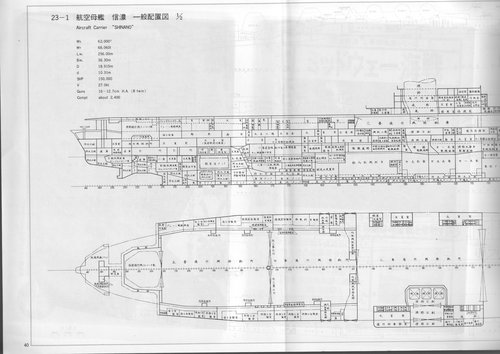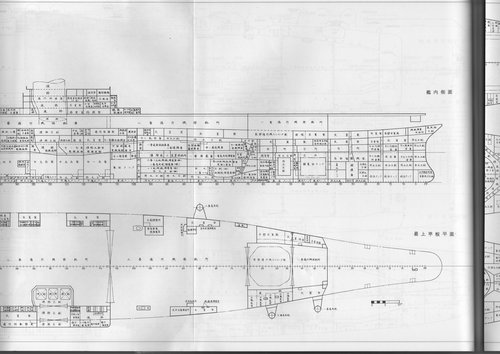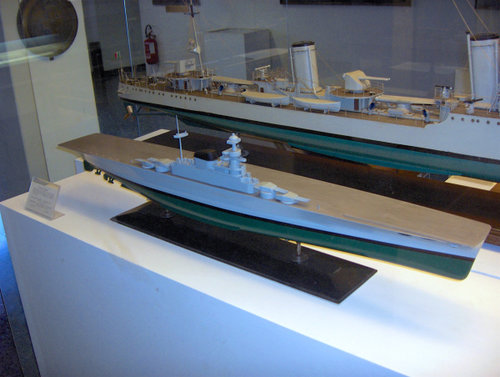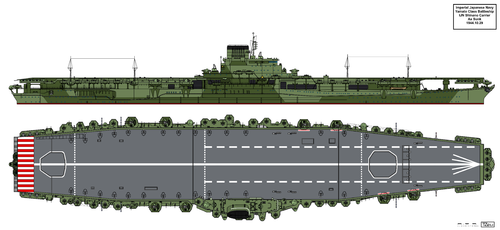Somewhat off topic, but in connection with the Italian plans mentioned above, I went into some thoughts on Italian shipbuilding around my what-if 1942 RN Far East scenario over at All the worlds battlecruisers.
I think we can take any Italian naval plans with a pinch of salt, by 1940 they were already firmly down the industrial priority list behind the Army and the Air Force and their shipbuilding industry could just not make up any shortfalls in capacity.
Italian shipbuilding during the war was not a huge success.
The Venetos took about six years each to build and Impero was never completed.
Aquila was a substantial reconstruction, nearly completed just as Mussolini's regime crumbled. The more basic Sparviero was more akin to a large merchant carrier the British were converting rather quickly. Only begun in 1942 the time ran out before much more than stripping her superstructure was completed.
No heavy or light cruiser was completed after 1937, the two Cianos being cancelled even before she entered the war. Even the two Thai cruisers taken over were never completed due to material shortages.
Twelve Capitani Romanis were laid down during September-October 1939, a rather grandiose gesture that must have caused bottlenecks in material and armament and engines. Despite being relatively small 3,600 ton unarmoured ships, only three were ever completed nearly 4 years later.
No fleet destroyers were laid down between 1937 and 1940, just 7 repeat Soldatis. The following D'Oro-class was a sound design but the crash programme of 20 ships barely got onto the slips, only 9 being laid down just months before Italy was out of the war.
The bulk of the wartime destroyers built were the Ciclones, repeats of the 1933-35 Orsa-class and it was late 1942 before most of these completed, only 16 being built. More escorts were sought and in 1942 the Spica was enlarged as the Ariete, a 745-ton torpedo boat, 42 were planned but actually these small ships did relatively well with 16 completed for the Italians or the Germans. The true escort corvette, the Gabbiano-class, was built in bulk and at speed but again it was 1942 before Italy reacted to its wartime needs and most of them again fell into German hands.
During the 1930s the Italians had been churning out submarines, by 1940 most had been completed. Wartime construction totalled about 22 completed submarines, most of the Flutto series submarines never completed and the Romolos were an interesting way to try and beat the Allied blockade but perhaps a waste of precious resources.
Some of these problems outlined were due to the war cutting off supplies and material but its clear that naval shipbuilding (apart from submarines) tailled off quite dramatically during 1937-40 and even for 1941 little new construction seems to have been planned. This suggests cost cutting by reducing naval construction expenditure. There seems to have been a lack of foresight about escorts and certainly it took the Italians too long to begin any kind of wartime construction programme which never really got going until 1942 with any momentum.
In my scenario its possible some of the planned sloops and auxiliaries may have been started during 1941, the diesel-powered Orsa derivative might have taken a while to come to fruition until the engines were ready, a pair of Cianos would probably have been built as planned but I doubt much concrete would have been accomplished by 1942 towards a proper 'breakout fleet'.
The above is a rather lamentable record for any belligerent in the war, certainly one that aspired to Great Power status as a naval power.
I did not touch the question of the ex-French ships and submarines acquired or salvaged after Toulon, the majority never entered Italian service, even the relatively undamaged ones and the bulk of them were only nearing completion of refits when the Germans grabbed them. As ceccherini says, the lack of oil fuel was crippling. The Navy certainly never shied away from the fighting, they would have done more had they had better resources behind them.


















